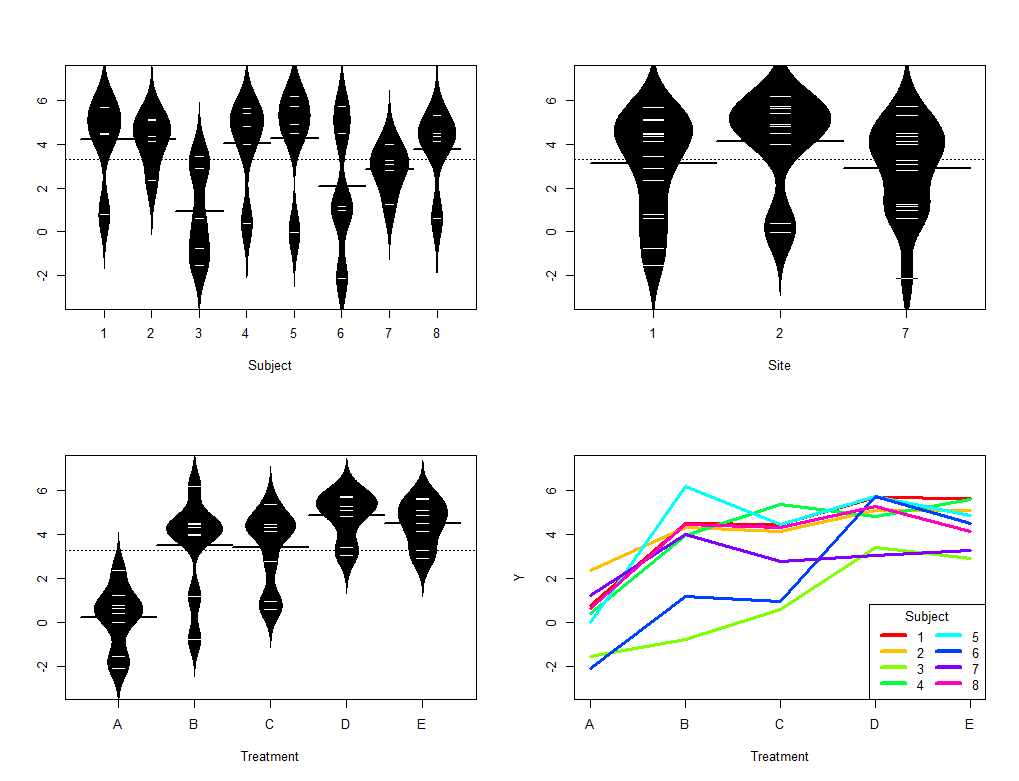The situation is somewhat different from what I thought. In case someone else can answer it, here is the data and my understanding of (I do not know SAS well...) the analysis in R:
require(beanplot)
require(lme4)
dat.full<-structure(list(Subject = c(1L, 1L, 1L, 1L, 1L, 2L, 2L, 2L, 2L,
2L, 3L, 3L, 3L, 3L, 3L, 4L, 4L, 4L, 4L, 4L, 5L, 5L, 5L, 5L, 5L,
6L, 6L, 6L, 6L, 6L, 7L, 7L, 7L, 7L, 7L, 8L, 8L, 8L, 8L, 8L),
Treatment = structure(c(4L, 5L, 3L, 1L, 2L, 3L, 4L, 2L, 5L,
1L, 2L, 3L, 1L, 4L, 5L, 4L, 5L, 3L, 1L, 2L, 3L, 4L, 2L, 5L,
1L, 5L, 1L, 4L, 2L, 3L, 4L, 5L, 3L, 1L, 2L, 3L, 4L, 2L, 5L,
1L), .Label = c("A", "B", "C", "D", "E"), class = "factor"),
Site = c(1L, 1L, 1L, 1L, 1L, 1L, 1L, 1L, 1L, 1L, 1L, 1L,
1L, 1L, 1L, 2L, 2L, 2L, 2L, 2L, 2L, 2L, 2L, 2L, 2L, 7L, 7L,
7L, 7L, 7L, 7L, 7L, 7L, 7L, 7L, 7L, 7L, 7L, 7L, 7L), y = c(5.68387,
5.65, 4.45098, 0.79048, 4.50455, 4.13208, 5.10459, 4.34468,
5.07556, 2.36296, -0.77037, 0.59167, -1.53191, 3.42, 2.89231,
4.80312, 5.60606, 5.38, 0.39474, 3.97714, 4.46667, 5.73333,
6.17391, 4.86957, -0.02, 4.4875, -2.10667, 5.71579, 1.17895,
0.97576, 3.05083, 3.25473, 2.7925, 1.23, 3.98769, 4.32754,
5.2875, 4.46575, 4.12787, 0.61481)), .Names = c("Subject",
"Treatment", "Site", "y"), class = "data.frame", row.names = c(NA,
-40L))
par(mfrow=c(2,2))
beanplot(dat.full$y~dat.full$Subject, xlab="Subject",
ylim=c(min(dat.full$y)-1, max(dat.full$y)+1))
beanplot(dat.full$y~dat.full$Site, xlab="Site",
ylim=c(min(dat.full$y)-1, max(dat.full$y)+1))
beanplot(dat.full$y~dat.full$Treatment, xlab="Treatment",
ylim=c(min(dat.full$y)-1, max(dat.full$y)+1))
Nsubj<-length(unique(dat.full$Subject))
plot(0,0, type="n",xlim=c(1,5), xaxt="n", xlab="Treatment",
ylab="Y", ylim=c(min(dat.full$y)-1, max(dat.full$y)+1))
axis(side=1, at=as.numeric(unique(dat.full$Treatment)),
labels=unique(dat.full$Treatment))
for(i in 1:Nsubj){
sub<-dat.full[which(dat.full$Subject==unique(dat.full$Subject)[i]),]
sub<-sub[sort(as.numeric(sub$Treatment), index.return=T)$ix,]
lines(sub$Treatment,sub$y, col=rainbow(Nsubj)[i], lwd=3)
}
legend("bottomright", legend=unique(dat.full$Subject), col=rainbow(Nsubj),
lwd=4, title="Subject", ncol=2)
dat1<-dat.full[which(dat.full$Site %in% 1),]
dat27<-dat.full[which(dat.full$Site %in% c(2,7)),]
fit.all<-lmer(dat.full$y~dat.full$Treatment + (1|dat.full$Subject))
fit1<-lmer(dat1$y~dat1$Treatment + (1|dat1$Subject))
fit27<-lmer(dat27$y~dat27$Treatment + (1|dat27$Subject))

> fit.all
Linear mixed model fit by REML ['lmerMod']
Formula: dat.full$y ~ dat.full$Treatment + (1 | dat.full$Subject)
REML criterion at convergence: 127.467
Random effects:
Groups Name Std.Dev.
dat.full$Subject (Intercept) 1.142
Residual 1.064
Number of obs: 40, groups: dat.full$Subject, 8
Fixed Effects:
(Intercept) dat.full$TreatmentB dat.full$TreatmentC
0.2168 3.2660 3.1728
dat.full$TreatmentD dat.full$TreatmentE
4.6331 4.2786
> fit1
Linear mixed model fit by REML ['lmerMod']
Formula: dat1$y ~ dat1$Treatment + (1 | dat1$Subject)
REML criterion at convergence: 37.0667
Random effects:
Groups Name Std.Dev.
dat1$Subject (Intercept) 1.8608
Residual 0.8506
Number of obs: 15, groups: dat1$Subject, 3
Fixed Effects:
(Intercept) dat1$TreatmentB dat1$TreatmentC dat1$TreatmentD
0.5405 2.1524 2.5177 4.1956
dat1$TreatmentE
3.9988
> fit27
Linear mixed model fit by REML ['lmerMod']
Formula: dat27$y ~ dat27$Treatment + (1 | dat27$Subject)
REML criterion at convergence: 76.0409
Random effects:
Groups Name Std.Dev.
dat27$Subject (Intercept) 0.7462
Residual 1.1876
Number of obs: 25, groups: dat27$Subject, 5
Fixed Effects:
(Intercept) dat27$TreatmentB dat27$TreatmentC dat27$TreatmentD
0.02258 3.93411 3.56592 4.89554
dat27$TreatmentE
4.44657
My understanding is that @AaronZeng wants to know under what conditions the residuals can be fit.all>fit27>fit1. This is not the case in the example data.

